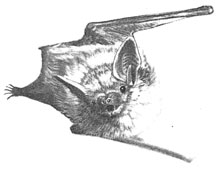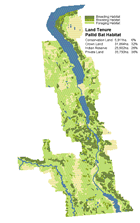|
Habitat Atlas for Wildlife at Risk
Pallid Bat
Antrozous pallidus

Pallid
Bat
|

- Total length: 11.5 cm; wingspan: 35.0 cm.
- Large ears: 2.6-3.3 cm long.
- Weight: 17 grams.
- Dorsal fur is pale yellow with a tinge of brown,
while the underside fur is creamy white.
- Pale, broad ears which extend well beyond the
ears when pushed forward.
- The snout is square with a shallow ridge on top
and a scroll-shaped end.
Status:
British Columbia Red List
Canada: Vulnerable
Special Significance
The Pallid Bat is one of the rarest mammals in British
Columbia. While this species appears to be confined
to the southern Okanagan Valley, more surveys are
required to delimit its range in British Columbia.
With such a small range in Canada, this species may
be subject to extirpation (no longer exist in Canada)
if environmental conditions change. It is the second
largest bat in British Columbia and is unique in
that it catches large ground-dwelling insects by
listening for their rustling sounds and pouncing
on them from out of the air. Conservation of known
roosting sites, such as rock crevices and ponderosa
pine trees, as well as protection of low elevation
shrub-grasslands, are important factors in helping
to ensure the continued survival of the Pallid Bat.
Distribution
- In British Columbia, occur in the South Okanagan
Valley as far north as Okanagan Falls; may also occur
in the
Similkameen Valley, Cariboo and Boundary regions.
- Restricted to low elevations (300 to 490 metres).
- Found nowhere else in Canada.
Habitat
- Pallid Bats occur in arid desert areas, often near
rocky outcrops and water.
- In the Okanagan Valley, these bats are restricted
to low elevation grasslands and ponderosa pine forests
in the vicinity of cliff faces.
- Night roosts are in close proximity to foraging
areas; prefer live ponderosa pines, rock shelters,
open buildings,
porches, bridges, shallow caves, mines and other
human-made structures.
- Day roosts include rock crevices in steep cliffs,
stone piles, man-made structures and trees.
- Maternity colonies occur in horizontal rock crevices.
- Forage over tracts of open grassland, sparsely
covered with shrubs and often bordered by ponderosa
pines;
gravel roads may also provide foraging corridors.
- Nothing is known about migration or possible hibernation
of British Columbia population; hibernation sites
may include buildings, rock crevices, mine tunnels
and
caves.
Reproduction
- Mating occurs from October to December; the gestation
period is about nine weeks.
- Young are born in late May to mid-July.
- Unlike most bat species, the Pallid Bat commonly
bears two young; may only have one young per litter
in British
Columbia as they are at the northern limit of their
range.
- Young bats grow rapidly; they are capable of flight
at 4 to 5 weeks of age and attain adult size at
eight weeks.
Food Habits
- Pallid Bats are late feeders, leaving day roosts
about 45 minutes after sunset.
- Usually glean prey from the ground and the foliage
of trees and shrubs; occasionally pursue insects
in the air using echolocation.
- Consume large invertebrates including beetles,
crickets, grasshoppers, moths and lacewings; there
are records
of this bat preying on small lizards and a rodent.
- While hunting, Pallid Bats fly slowly, close to
the ground, with rhythmic dips and rises; while hunting
prey on the ground it listens for their rustling
sounds.
Interesting Facts
- After feeding, Pallid Bats cluster together at
the night roost and become torpid (lower their body
temperature
and metabolic rate) for several hours if temperatures
are cool.
- A social bat, this species emits a variety of
vocalizations for communicating in a colony; many
calls are audible
to the human ear.
- Produce a musky skunk-like odour from glands on
the muzzle which may be a defensive mechanism for
repelling
predators.
Threats
- Extensive land development in the Okanagan
has eliminated or fragmented their habitat
(low elevation
ponderosa pine forest, grasslands and riparian
areas).
- Heavy grazing may reduce availability of
ground-dwelling insects.
- Very sensitive to human disturbance.
- Susceptible to cat predation.
Management Considerations
- Avoid the use of pesticides, particularly
near wetlands and riparian areas.
- Protect known roosting sites from disturbance.
- Preserve old mine shafts, but erect gates
to prevent human access to caves and mine shafts.
- Maintain water levels in ponds as sources
of drinking water and foraging areas.
- Discourage, free-roaming domestic cats,
especially near potential bat habitat.
|
References
1. Nagorsen, D.W. and R.M. Brigham. 1993. Bats of British Columbia.
Royal British Columbia Museum Handbook, Victoria, British Columbia
2. Holroyd, S.L., R.M.R. Barclay, L.M. Merk and R.M.
Brigham. 1994. A survey of the bat fauna of the dry interior of British
Columbia. Ministry of Water, Land and Air Protection, Lands and Parks.
Victoria, British Columbia.
|